

Marx and the Rift in the Universal Metabolism of Nature. This article is an expanded and slightly altered version of a keynote address under the same title presented to the Marxism 2013 Conference in Stockholm on October 20, 2013.

That address built on ideas introduced in the author’s Rosa Luxemburg Lecture, “The Great Rift,” presented to the Rosa Luxemburg Stiftung in Berlin on May 28, 2013. Capitalist World-Ecology. Part II: From Geology to Geohistory in the Capitalist World-Ecology Jason W.
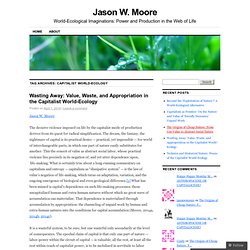
Moore. Tatlin's Tower. 2000 Russia 1 rub 50 kopeks stamp.
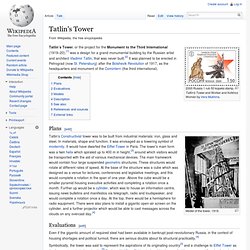
Tatlin's Tower and Worker and Kolkhoz Woman by Vera Mukhina. Tatlin’s Tower, or the project for the Monument to the Third International (1919–20),[1] was a design for a grand monumental building by the Russian artist and architect Vladimir Tatlin, that was never built.[2] It was planned to be erected in Petrograd (now St. Petersburg) after the Bolshevik Revolution of 1917, as the headquarters and monument of the Comintern (the third international). Plans[edit] Impressions of the Charnel-House. Away from all suns - Home.
The Politics of Ontology: Anthropological Positions — Cultural Anthropology. At first blush, “ontology” and “politics” make strange bedfellows.
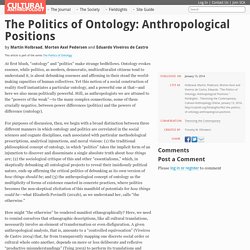
Ontology evokes essence, while politics, as modern, democratic, multiculturalist citizens tend to understand it, is about debunking essences and affirming in their stead the world-making capacities of human collectives. Yet this notion of a social construction of reality itself instantiates a particular ontology, and a powerful one at that—and here we also mean politically powerful. Still, as anthropologists we are attuned to the “powers of the weak”—to the many complex connections, some of them crucially negative, between power differences (politics) and the powers of difference (ontology). How might “the otherwise” be rendered manifest ethnographically?
AnthroBase - Social and Cultural Anthropology - A searchable database of anthropological texts. World-systems theory. A world map of countries by trading status, late 20th century, using the world system differentiation into core countries (blue), semi-periphery countries (purple) and periphery countries (red).
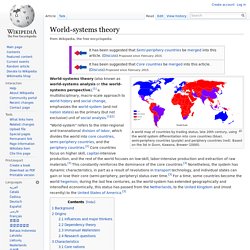
Based on the list in Dunn, Kawana, Brewer (2000). World-systems theory (also known as world-systems analysis or the world-systems perspective),[1] a multidisciplinary, macro-scale approach to world history and social change, emphasizes the world-system (and not nation states) as the primary (but not exclusive) unit of social analysis.[1][2] Background[edit] Gringo Trails. Coconut Revolution - "The world's first successful eco-revolution." - HQ - Full.
Ecological anthropology. Some societies have proven to be sustainable for centuries or even millennia.
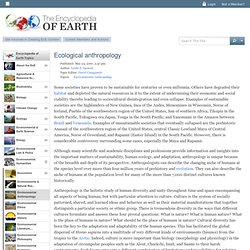
Others have degraded their habitat and depleted the natural resources in it to the extent of undermining their economic and social viability thereby leading to sociocultural disintegration and even collapse. (1 of 4) The Bomb Under The World - The Human Race: A Species at the Crossroads - by Gwynne Dyer. Nature–culture divide. The nature–culture divide, refers to a theoretical foundation of contemporary anthropology.
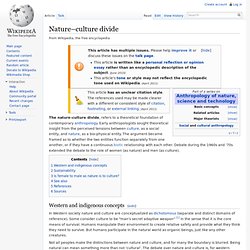
Early anthropologists sought theoretical insight from the perceived tensions between culture, as a social entity, and nature, as a bio-physical entity. The argument became framed as to whether the two entities function separately from one another, or if they have a continuous biotic relationship with each other. Debate during the 1960s and '70s extended the debate to the role of women (as nature) and men (as culture). Ecophenomenology. A New Geometry of fear :: the road from Smithson to Nelson February 15, 2013 · by simeon kaminski · in Academic art, Conceptual art, Contemporary Art, Environment, Galleries, geography, human geography, infrastructure, Research art, roads, Uncategorized · I’ve mentioned Robert Smithson before in a previous post and still haven’t quite satisfied myself (and probably never will) that whatever I’ve read and written about his work Asphalt Rundown adequately describes the profound influence this work has had on a particular type of environmental art.

The Ivory Tunnel: What is Ecological Phenomenology (Ecophenomenology)? If environmental philosophy is a young field, ecological phenomenology as such is even younger, dating back perhaps two decades to foundational works, most notably Erazim Kohak's The Embers and the Stars (University of Chicago Press, 1984) and Neil Evernden's The Natural Alien (University of Toronto Press, 1985).
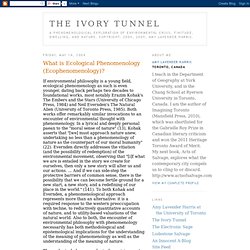
Both works offer remarkably similar invocations to an encounter of environmental thought with phenomenology. In a lyrical and deeply personal paean to the "moral sense of nature" (13), Kohak asserts that "[we] must approach nature anew, undertaking no less than a phenomenology of nature as the counterpart of our moral humanity" (22). Evernden directly addresses the vitiation (and the possibility of redemption) of the environmental movement, observing that "[i]f what we are is entailed in the story we create for ourselves, then only a new story will alter us and our actions. ... Jakob von Uexküll. Jakob Johann von Uexküll, 1903 "Early Scheme for a circular Feedback Circle" from Theoretische Biologie 1920.

Small circular Feedback Pictograms between the Text Schematic view of a cycle as an early biocyberneticist. How should we think of nature? What is Ecophenomenology? David Wood (2001) The Need for a Rapprochment with Naturalism. An Order of Forest: Notes on “Friction: An Ethnography of Global Connection” by Anna Lownhaupt Tsing (Princeton University Press, 2005) Anna Lowenhaupt Tsing’s most recent book proposes “friction” as a paradigm through which to understand the overlapping and often conflicting objectives of social entities that coalesce around the forest resources of the South Kalimantan region of Borneo.
Tsing claims to pioneer a new method for understanding how “local” and “global” intersect through the actions of different groups such as the Meratus Dayak who inhabit South Kalimantan, Indonesian students’ nature clubs, Suharto and post-Suharto governments, foreign mining and timber corporations, and international and domestic NGO’s. While it has become quite commonplace to direct social-scientific fieldwork towards the study of local-global imbrications, Tsing’s work is noteworthy for her deft and continual movement between a particular place and its global tentacles—not only when chronicling the activities of the Meratus Dayak, but also when dealing with international NGO’s and corporations. Offers a vivid image of global friction. Neil Postman. Neil Postman (March 8, 1931 – October 5, 2003) was an American author, media theorist and cultural critic, who is best known by the general public for his 1985 book about television, Amusing Ourselves to Death.
For more than forty years, he was associated with New York University. Postman was a humanist, who believed that "new technology can never substitute for human values". Biography[edit] Postman was born to a Jewish family in New York City, where he would spent most of his life.[1] In 1953, he graduated from State University of New York at Fredonia where he played basketball.[2][3] At Teachers College, Columbia University he was awarded a master's degree in 1955 and an Ed.D in 1958.[2] In 1959, he began teaching at New York University (NYU).[2] He died of lung cancer in Flushing, Queens on October 5, 2003.[2] Works[edit] The Gnostic Religion: Amazon.co.uk: Hans Jonas.
Book Description Publication Date: 16 Jan 2001 The Message of the Alien God and the Beginnings of Christianity Frequently Bought Together Customers Who Bought This Item Also Bought Sell a Digital Version of This Book in the Kindle Store If you are a publisher or author and hold the digital rights to a book, you can sell a digital version of it in our Kindle Store. What Other Items Do Customers Buy After Viewing This Item? Lewis Mumford. Lewis Mumford, KBE (October 19, 1895 – January 26, 1990) was an American historian, sociologist, philosopher of technology, and literary critic. Particularly noted for his study of cities and urban architecture, he had a broad career as a writer.
Mumford was influenced by the work of Scottish theorist Sir Patrick Geddes and worked closely with his associate the British sociologist Victor Branford. Life[edit] Mumford was born in Flushing, Queens, New York, and graduated from Stuyvesant High School in 1912.[2] He studied at the City College of New York and The New School for Social Research, but became ill with tuberculosis and never finished his degree. In 1918 he joined the navy to serve in World War I and was assigned as a radio electrician.[1][3] He was discharged in 1919 and became associate editor of The Dial, an influential modernist literary journal.
Introduction—“Animism” Anselm Franke. Human Relations Area Files. University of Manchester. Aluna the Movie. Naomi Klein: Green groups may be more damaging than climate change deniers. Canadian author Naomi Klein is so well known for her blade-sharp commentary that it’s easy to forget that she is, above all, a first-rate reporter. I got a glimpse into her priorities as I was working on this interview. Two great new anthropology classes. Anthropology. Andy Burgess Wood Sculptor. Richard G. Wilkinson. Richard Gerald Wilkinson (born 1943) is a British social epidemiologist, author and advocate. He is Professor Emeritus of Social Epidemiology at the University of Nottingham, having retired in 2008. Degrowth. Niklas Luhmann. Ethnomethodology. Ethnomethodology is the study of methods people use for understanding and producing the social order in which they live.[1] It generally seeks to provide an alternative to mainstream sociological approaches.[2] In its most radical form, it poses a challenge to the social sciences as a whole.[3] On the other hand, its early investigations led to the founding of conversation analysis, which has found its own place as an accepted discipline within the academy.
Emergent Properties - International encyclopedia of the social and behavioral sciences 4 - Behavioral science - Деловая библиотека. The Palm at the End of the Mind: Relatedness, Religiosity, and the Real: Amazon.co.uk: Michael Jackson. Lindisfarne Association. Songs At the River's Edge: Stories From a Bangladeshi Village: Amazon.co.uk: Katy Gardner. Future of Nostalgia: Amazon.co.uk: Svetlana Boym. Aluna. Missing women of Asia. Profile on TED.com. Secrets of the Tribe - PREVIEW. Kundalini syndrome. The Alliance for Wild Ethics. Open Source Ecology. Great Transition. Planetary phase of civilization. Eco-communalism. Lectures. Speed of Light Salford · Speed of Light. The Spell of the Sensuous: Perception and Language in a More-Than-Human World Vintage: Amazon.co.uk: David Abram. Phosphene. Literary Review: ‘Animals and Psychedelics’ by Giorgio Samorini « Psychedelic Press UK. Overview effect.
We Have Never Been Blogging: Creature of habitus: Latour on Bourdieu Pt. 1. Sebastião Salgado in Siberia - in pictures. Dr Michael W. Scott - People - Anthropology. Martin Heidegger vs Bruno Latour. Gregory Bateson’s Flat Ontology. Actor-Network Theory in Plain English. Actor–network theory. Deinstitutionalising Society: Individual and Institution. Mindwalk (1990) [Sub. Esp.- Eng Captions] Electronic Awakening: Emergence of the neo-tribal community. Dig the sounds not uraniumOhms Not Bombs. The Shadow of Dionysus: Contribution to the Sociology of the Orgy: Amazon.co.uk: Michel Maffesoli. Edgecentral: Dionysus Now: The Island of Fire and the Immortal Present.
Stuff: Amazon.co.uk: Daniel Miller. The Mother of All Demos, presented by Douglas Engelbart (1968) Swarm Intelligence The Morgan Kaufmann Series in Artificial Intelligence: Amazon.co.uk: Russell C. Eberhart, James Kennedy, Yuhui Shi, et al. Swarm Intelligence - Russell C. Eberhart, Yuhui Shi, James Kennedy. Humanistic psychology. Human Potential Movement. Using Your Personal DNA Test. Alfred L. Yarbus. Great Diagrams in Anthropology , Linguistics, and Social Theory. Semantic Networks. Thoughtform. Neuroanthropology. Weston La Barre. THE GHOST DANCE: THE ORIGINS OF RELIGION BY La Barre, Weston Author Paperback on 03 , 2010: Amazon.co.uk: Weston La Barre. 27th Sept - An Ecology of Mind, with Nora Bateson. Interactive Talks. Arthur Tansley. Mapping The Human Story. Everything is connected. Double bind. Steps to an Ecology of Mind: Collected Essays in Anthropology, Psychiatry, Evolution and Epistemology: Amazon.co.uk: Gregory Bateson.
Cultural universal. Shamanism: Archaic Techniques of Ecstasy Bollingen Series General: Amazon.co.uk: Wendy Doniger, Mircea Eliade, Willard R. Trask. What are some must-read books for someone going into graduate studies in anthropology? Why. BBC Radio 4 - Leading Edge, Anthropology and Environment. Tim Ingold. The Do It Yourself Scholar. 100 Incredible Anthropology Lectures Online. Diotalevi. Seminar in Contemporary Theory: Anthropology and Literature (Dominy, 1998) Cultural ecology.